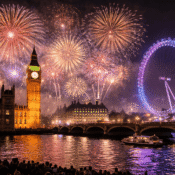13 Fascinating Facts About Rajasthan That Will Amaze You in 2025!!

13 Fascinating Facts About Rajasthan That Will Amaze You in 2025!!
Many mediaeval forts and palaces can be found in Rajasthan, the country of the maharajas. This vibrant Indian palace state is a popular destination for tourists from all around the world because it offers royalty, customs, culture, and delectable food. The area has an illustrious past, and Rajasthan’s architectural wonders tell the tale of its heyday. Let’s know more facts about Rajasthan in this amazing and interesting blog!!
There are many things about this amazing Indian tourist site that astound visitors. Admirable things include man-made wonders, geographical treasures, and innumerable deeply ingrained civilisations that have produced exclusive beliefs and attitudes that have eventually flourished in the societies. These ideas and facts are now considered fascinating facts about Rajasthan, and any tourist who wants to experience its magnificent experiences needs to be aware of them!
13 Interesting Facts About Rajasthan
The following fascinating facts about Rajasthan, which includes colour-coded cities with friendly residents, delicious cuisine and actual spices, and documented tales of realms and geography, have surprised tourists from all over the world. Go ahead and read!
1. Geographical Area

India’s largest state is this vibrant patchwork. Its area is 342,239 square kilometres, and as of the 2011 Census, its population is 68,548,437**. On March 30, 1949, 22 kingdoms of princely states united under the common name of Rajasthan.
2. Kalibangan

The remnants of prehistoric and pre-Mauryan civilisations can be found in Rajasthan’s Kalibangan, which is situated next to the meeting point of the Drishadvati and Saraswati Rivers. The first known ploughed field in the world is found on the lands of Kalibangan.
3. Mandore

The queen of Ravana’s dominion, Mandodari, was a native of Mandore, Rajasthan. Their marriage ceremony is thought to have taken place at the same location. It was in Ravana Chawri when the pair made their lifelong vows. This important location was also Marwar’s capital.
4. Bhangarh

Among India’s most haunted forts is Bhangarh, which is situated in the Alwar district. In the sixteenth century, Raja Bhagwant of Amber built the fort. It is said that a Tantrik who attempted to court the lovely princess Ratnavati cursed the entire village of Bhangarh. Since entry to Bhangarh is forbidden between sunset and sunrise, the excitement of this location can only be experienced during the day.
5. Thar

The state of Rajasthan is home to Thar, the ninth biggest subtropical desert in the world. Though 60% of this remote desert is in Rajasthan, there are still parts of Thar in Punjab, Gujarat, Haryana, and Sindh (Pakistan). High-velocity winds create shifting dunes, and the area stays dry almost all year round.
6. Aravalli

The Aravalli Range originated when the ocean divided the Indian Plate from the Eurasian Plate. In the past, this important shield was higher and was created by cratonic collisions. The majority of this remote rocky range, which is over 560 kilometers long, passes through Rajasthan.
7. Kumbhalgarh Fort

Maharana Kumbha created the current version of Kumbhalgarh Fort. Kumbhalgarh Fort is one of the most ornate forts in India due to its massive structure. The fort is situated on a mountaintop about 1,100 meters above sea level, with 36-kilometer-long boundary walls. The palace is said to feature the world’s longest fortification.
8. Hawa Mahal

In the 18th century, Maharaja Sawai Pratap Singh built the architectural wonder known as Hawa Mahal, which is composed of pink and red sandstone. With its intricate latticework and 953 Jharokhas (windows), the palace’s facade resembles the honeycomb of a beehive.
9. Vibrant Culture

The fact that some of Rajasthan’s largest cities are colour-coded is among its most astounding features. Because Maharaja Sawai Ram Singh enacted an edict in 1876 requiring citizens to paint their homes pink in honour of the Prince of Wales and Queen Victoria, Jaipur is known as the Pink City. Once signifying the dwelling of Brahmins, Jodhpur’s blue houses have come to represent the city’s colour. The Golden City moniker, which draws influence from the hues of the Thar Desert, exalts the tales of Jaisalmer.
10. Luni River

The Luni River rises in the Pushkar Valley and travels across the Thar Desert before arriving in the swampy Kutch region. Lavanvati, which translates to “salt river” in Sanskrit, is the name of the river. The water in the river is extremely salinised.
11. Tourist Attractions

Eight UNESCO World Heritage monuments, including Chittorgarh Fort, Kumbhalgarh Fort, Ranthambore Fort, Gagron Fort, Amber Fort, Jaisalmer Fort, Keoladeo National Park, and Jantar Mantar, are located in the dynamic state of Rajasthan. All of the previously listed historical landmarks, with the exception of the national park, showcase the magnificent architecture of the Royal Rajputs.
12. Luxurious Transfers

The Indian Railways and Rajasthan Tourism Development Corporation launched the Palace on Wheels, one of the most opulent trains in India, in 1982. This train’s concept and design are inspired by Rajasthani royal culture and traditions. The train can accommodate 104 passengers in its 23 carriages.
13. Kuldhara

The remote Rajasthani village of Kuldhara lies 18 kilometres from the metropolis of Jaisalmer. The Paliwal Brahmins founded the location in the thirteenth century. Studies indicate that an earthquake caused the location to be abandoned in the early 19th century. Locals, however, tell a different tale. They think that the villagers cursed the village and ran out on a pitch-black night out of fear of the Diwan’s fury.
All Categories
- Adventure
- Australia
- City Tours
- Customized Holidays
- Domestic
- Dubai
- Europe
- Forex
- Group Holidays
- Honeymoon
- India
- Indonesia
- Informative
- International
- Korea
- Leisure Holidays
- Life Style
- Mauritius
- philippines
- Pilgrimage
- places to visit
- Remittance
- Singapore
- Thailand
- Things To Do
- Turkey
- Uncategorized
- Valentine
- Varanasi
- Vietnam
- VISA
- Weekend Getaways
- Wild Camping
Recent Posts
New Year, New Destinations: 10 Best Places to Visit for New Year 2026!!
Indian Rupee Value Abroad: 7 Cheapest Countries for Indians to Travel in 2026!!
Explore Kashmir’s Valley of Flowers, Which Reveals the Enchanting World of Nature
Tags






